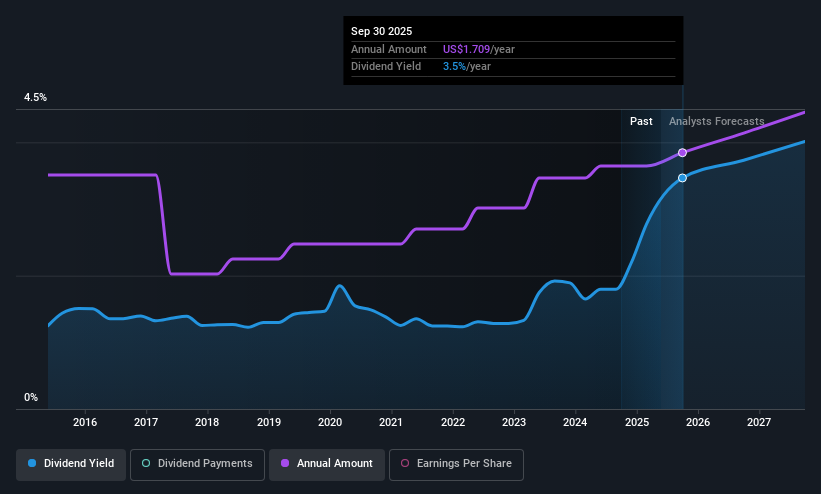- United States
- /
- Chemicals
- /
- NYSE:ASH
Here's Why We're Wary Of Buying Ashland's (NYSE:ASH) For Its Upcoming Dividend

Some investors rely on dividends for growing their wealth, and if you're one of those dividend sleuths, you might be intrigued to know that Ashland Inc. (NYSE:ASH) is about to go ex-dividend in just 4 days. The ex-dividend date is usually set to be one business day before the record date, which is the cut-off date on which you must be present on the company's books as a shareholder in order to receive the dividend. The ex-dividend date is important because any transaction on a stock needs to have been settled before the record date in order to be eligible for a dividend. Accordingly, Ashland investors that purchase the stock on or after the 30th of May will not receive the dividend, which will be paid on the 15th of June.
The company's next dividend payment will be US$0.415 per share, and in the last 12 months, the company paid a total of US$1.62 per share. Based on the last year's worth of payments, Ashland stock has a trailing yield of around 3.4% on the current share price of US$49.30. Dividends are a major contributor to investment returns for long term holders, but only if the dividend continues to be paid. That's why we should always check whether the dividend payments appear sustainable, and if the company is growing.
We've discovered 1 warning sign about Ashland. View them for free.Dividends are usually paid out of company profits, so if a company pays out more than it earned then its dividend is usually at greater risk of being cut. Ashland reported a loss after tax last year, which means it's paying a dividend despite being unprofitable. While this might be a one-off event, this is unlikely to be sustainable in the long term. Given that the company reported a loss last year, we now need to see if it generated enough free cash flow to fund the dividend. If Ashland didn't generate enough cash to pay the dividend, then it must have either paid from cash in the bank or by borrowing money, neither of which is sustainable in the long term. Over the last year, it paid out dividends equivalent to 233% of what it generated in free cash flow, a disturbingly high percentage. Unless there were something in the business we're not grasping, this could signal a risk that the dividend may have to be cut in the future.
View our latest analysis for Ashland
Click here to see the company's payout ratio, plus analyst estimates of its future dividends.

Have Earnings And Dividends Been Growing?
Stocks in companies that generate sustainable earnings growth often make the best dividend prospects, as it is easier to lift the dividend when earnings are rising. If earnings decline and the company is forced to cut its dividend, investors could watch the value of their investment go up in smoke. Ashland reported a loss last year, but at least the general trend suggests its income has been improving over the past five years. Even so, an unprofitable company whose business does not quickly recover is usually not a good candidate for dividend investors.
Another key way to measure a company's dividend prospects is by measuring its historical rate of dividend growth. Ashland has delivered 2.0% dividend growth per year on average over the past 10 years. Earnings per share have been growing much quicker than dividends, potentially because Ashland is keeping back more of its profits to grow the business.
We update our analysis on Ashland every 24 hours, so you can always get the latest insights on its financial health, here.
To Sum It Up
Should investors buy Ashland for the upcoming dividend? It's hard to get used to Ashland paying a dividend despite reporting a loss over the past year. Worse, the dividend was not well covered by cash flow. With the way things are shaping up from a dividend perspective, we'd be inclined to steer clear of Ashland.
So if you're still interested in Ashland despite it's poor dividend qualities, you should be well informed on some of the risks facing this stock. Every company has risks, and we've spotted 1 warning sign for Ashland you should know about.
A common investing mistake is buying the first interesting stock you see. Here you can find a full list of high-yield dividend stocks.
New: Manage All Your Stock Portfolios in One Place
We've created the ultimate portfolio companion for stock investors, and it's free.
• Connect an unlimited number of Portfolios and see your total in one currency
• Be alerted to new Warning Signs or Risks via email or mobile
• Track the Fair Value of your stocks
Have feedback on this article? Concerned about the content? Get in touch with us directly. Alternatively, email editorial-team (at) simplywallst.com.
This article by Simply Wall St is general in nature. We provide commentary based on historical data and analyst forecasts only using an unbiased methodology and our articles are not intended to be financial advice. It does not constitute a recommendation to buy or sell any stock, and does not take account of your objectives, or your financial situation. We aim to bring you long-term focused analysis driven by fundamental data. Note that our analysis may not factor in the latest price-sensitive company announcements or qualitative material. Simply Wall St has no position in any stocks mentioned.
About NYSE:ASH
Ashland
Provides additives and specialty ingredients in the North and Latin America, Europe, Asia Pacific, and internationally.
Adequate balance sheet and fair value.
Similar Companies
Market Insights
Community Narratives



